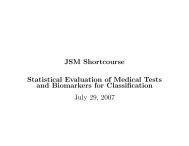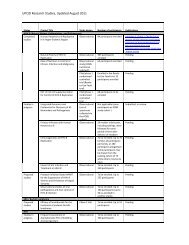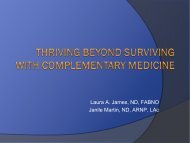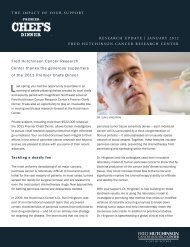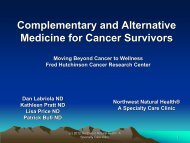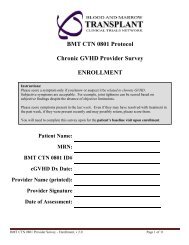Summer Undergraduate Research Program - Fred Hutchinson ...
Summer Undergraduate Research Program - Fred Hutchinson ...
Summer Undergraduate Research Program - Fred Hutchinson ...
You also want an ePaper? Increase the reach of your titles
YUMPU automatically turns print PDFs into web optimized ePapers that Google loves.
Analyzing the Antibody Response against H-Y Antigens<br />
Nathan Ord1 ; Takazu Kawase, M.D., Ph.D2 ; Edus Warren, M.D., Ph.D. 2<br />
1 Whitman College, Walla Walla, WA; 2 <strong>Fred</strong> <strong>Hutchinson</strong> Cancer <strong>Research</strong> Center, Seattle, WA<br />
Results<br />
Abstract<br />
Background<br />
2011 Lee Hartwell Poster Award<br />
XY<br />
Female to male (F→M) hematopoietic stem cell transplant (HSCT) exhibits:<br />
- Increased GVHD and GVL due to donor T-cell targeting mHAs<br />
- Recently demonstrated antibody against H-Y antigens (Miklos et al.)<br />
Hypothesis: KDM5D is the most important T-cell H-Y antigen and it will be highly<br />
immunogenic for B-cells as well<br />
To test this we obtained blood plasma from:<br />
- 39 HSCT F→M transplant patients<br />
- 16 HSCT patients with other donor/recipient gender combinations<br />
- 12 healthy female donors<br />
- 9 healthy male donors<br />
We tested for IgG antibody against:<br />
- 36 overlapping pentadecapeptide fragments representing residues 197-383 of KDM5D,<br />
peptides for a unique region of isoform 1, and several X-homologue peptides<br />
- Recombinant proteins DDX3Y, UTY, ZFY RPS4Y and E1F1AY, their X-homologues,<br />
and KDM5D-f (the one fragment currently purified) comprising residues 1320 to 1570<br />
We found:<br />
- 15 of 39 (38%) F→M HSCT samples were reactive with ≥1 KDM5D peptide while 7 of<br />
39 (18%) samples reacted with ≥3 KDM5D peptides.<br />
- 9 of 16 (56%) samples from other donor/recipient gender combinations were reactive<br />
with ≥1 KDM5D peptide and 2 of 16 (13%) were reactive with ≥3 KDM5D peptides.<br />
- Peptide specific results suggest that a potential target region for H-Y antibody exists<br />
around KDM5D281-375 - Strong antibody responses to KDM5D19 (VSSTLLKQHL--------SLEPC) were only<br />
observed in male recipients of female grafts (7 of 39) and responses to peptide 32<br />
were also primarily observed in F→M transplant patients.<br />
- Recombinant protein responses were detected most frequently for UTY, followed by<br />
KDM5D-f.<br />
- Antibodies to UTY were observed in 11 of 39 (28%) F→M patients and in 1 of 16<br />
(6%) patients with other donor/recipient gender combinations.<br />
Hematopoietic Stem Cell Transplant<br />
Donor Stem Cells<br />
GVHD<br />
No Rxn<br />
GVL<br />
The Bone marrow transplant replaces the blood forming cells of the patient with those of the donor. This<br />
reconstitutes the patient’s immune system and the engrafted T-cells interact with the host.<br />
Immune Cell Recognition<br />
148<br />
DNA polymorphisms result in differences in host/donor proteins, the<br />
donor immune system may recognize host peptide fragments displayed by<br />
MHC molecules as foreign resulting GVH or GVL effect against these<br />
minor histocompatibility antigens (mHAs).<br />
Minor Histocompatibility Antigens and the H-Y antigen system<br />
:<br />
XX XY<br />
Experimental Approach<br />
Coat 96 well plates with protein (protein fragments or peptides) in<br />
coating buffer<br />
Add plasma sample. If specific antibody exists in the plasma,<br />
the antibody will bind to the protein<br />
Add secondary antibody (anti human IgG antibody) conjugated with AP<br />
Add color development buffer and measure absorbance at 405 nm<br />
The female to male transplant scenario is a unique opportunity to study mHAs and their clinical significance<br />
because it restricts the search to just the Y-chromosome. Additionally, the gene must be expressed widely<br />
outside the testes, have a similar but non-identical X homolog, escape X inactivation, and reside outside the<br />
ampliconic region.<br />
Conclusions and Further Directions<br />
But what about the B cells?<br />
Conclusions<br />
1. Results suggest that KDM5D is an important target for post-transplant<br />
antibody<br />
2. There appears to be an antibody binding cluster near KDM5D281-375 3. The antibody response to H-Y antigens, particularly DDX3Y may not be<br />
as strong as previously suggested<br />
Further Directions<br />
1. Assay more samples. It is interesting that the healthy samples exhibit<br />
high antibody responses, does everyone have similar antibody?<br />
2. Does Rituximab benefit patients with ≥1 H-Y antibody response?<br />
3. And what about the rest of SMCY? Currently we are synthesizing the full<br />
recombinant protein, does an antibody epitope reside outside the region<br />
we assayed?<br />
4. How much antibody is present? Conduct sequential dilution to determine<br />
the antibody titer<br />
Y<br />
Y<br />
Y<br />
Y<br />
Y Y<br />
Y<br />
Y<br />
Y<br />
Y Y<br />
Y<br />
Y Y Y<br />
Y<br />
Y Y<br />
YY Y Y Y<br />
Y Y<br />
Y<br />
Y Y YY Y<br />
Y Y<br />
YY Y Y<br />
YY<br />
Y<br />
Y<br />
GVHD<br />
No Rxn ?<br />
Acknowledgements and References<br />
GVL<br />
I would like thank Hootie and everyone in the Warren lab; David Miklos for supplying recombinant<br />
protein; Jim Russo, Doug Juers, and Marilyn Gotz for helping me here; Jennifer Anderson, Jorden<br />
Canas, and the countless people who supported the internship program; and the Howard Hughes<br />
Medical Institute and Whitman College along with <strong>Fred</strong> <strong>Hutchinson</strong> Cancer <strong>Research</strong> Center for<br />
sponsoring this opportunity.<br />
Miklos, D et al. 2004. “Antibody response to DBY minor histocompatibility antigen is induced<br />
after allogeneic stem cell transplantation and in healthy female donors.” Blood. 103: 353-<br />
359<br />
Miklos, D et al. 2005. “Antibody responses to H-Y minor histocompatibility antigens<br />
correlate with chronic graft-versus-host disease and disease remission.” Blood. 105:<br />
2973-2978<br />
Murphy, K et al. Janeway’s Immuno Biology 7th Edition. New York: Garland Science, 2008.<br />
Although T-cells are the most relevant to both GVL and GVH, the efficacy of<br />
Rituximab in GVHD (a monoclonal CD20 antibody specific for B cells) and<br />
accumulating evidence has shown the presence and significance of antibodies in<br />
the H-Y transplant setting




